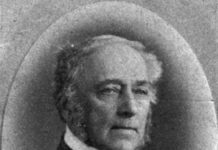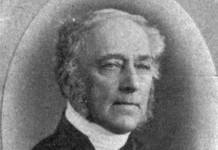by Doug MacDonald

Almost two hundred years ago, in 1826, the Church of England established the Rideau Townships pioneer mission Parish of St. James. The first parish church was St. James, built at Clothier’s Mill (Kemptville) in 1827 by the missionary Henry Patton.
In 1866, on the eve of Confederation, John Stannage, a complex and energetic “high Anglican”, became the sixth Rector of the Parish. Immediately, a head-on, unrelenting program of organization, fund raising and building was initiated. Prior to arriving in Kemptville, Stannage had built ten churches in Nova Scotia and in Upper Canada. In the villages surrounding St. James, he envisioned several small satellite churches. Using his money-raising talent, he wholeheartedly sought funding in England, to pay for curates, educate theological students and build Gothic Revival Churches.
In 1868, St. James Parish Hall was contracted and built. In 1869, construction was begun on his 11th church, St. John in Oxford Mills, followed in 1871 by St. Paul’s Marlborough, St. Anne’s Oxford Station in 1878 and St. Augustine’s at Acton’s Corners in 1879.
Much of John Stannage’s years at St. James were spent across the Atlantic in England on marathon fund raising trips. The money and gifts he gathered were doled out as he chose and directed.
At St. James Vestry in July, 1874, under the persuasive guidance of Stannage, it was agreed to replace the 1827 frame church and obtain funds to erect “a neat stone church” to honour the first Rector of the parish.
Reported in the Ottawa Free Press on August 24, 1874: “The Rev. John Stannage, the much respected rector of the village, has on foot a movement to build a new Episcopalian Church on Main Street (Clothier Street West), to be called the ‘Archdeacon Patton Memorial Church’…..the spire of the old church, knocked out of line of perpendicular by the gale…, still remains in that condition and looks very much as if another ‘puff’ would scatter it.”
It is believed that 50% of the cost of the new St. James, and up to 90% of the costs of the four satellite churches, were raised by Stannage in England. Of his success, he wrote in his diary that he had created “more churches, parsonages, school houses, and endowments than any one individual in Canada”.
In the final years of the 1870’s, his focus was on the new St. James. In May, 1878, the cornerstone was laid for the village church of cut blue limestone in the Canadian Gothic tradition. With the faith, fund raising entrepreneurship and vision of John Stannage, the talent of Montreal architect William Tutin Thomas, and the skill of the craftsmen and stone masons, a church of symmetry and beauty was created.
By early 1880, an exhausted John Stannage had organized the official opening of the church for St. James Day, Sunday, July 25, 1880. St. James was his 15th church and considered it his “Great Work”. Sadly, John Stannage died on May 13, 1880 and is buried in St. James cemetery. Today, St. James remains one of the most attractive churches in Ontario (the blue limestone now weathered to soft beiges). The handsome exterior is complimented by the simple beauty of the interior. The plaster on lathe walls pierced by magnificent stained glass windows, most significant of which is the glorious Stannage triptych above the altar dedicated: “To the glory of God and in memory of John Stannage”, donated by his sorrowing family – wife Eliza, daughter Anne Elizabeth and his five adopted sons.







